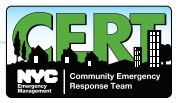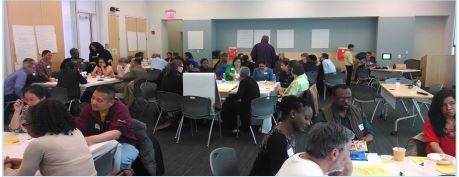6. EDUCATE YOUR COMMUNITY
OBJECTIVES:
-
Include community outreach/education as part of your planning.
-
Identify resources and develop strategies you can use to educate your community about being prepared for emergencies.
THINGS TO CONSIDER:
Education about individual preparedness benefits community preparedness. Educating community members will also raise the visibility of your network and planning and allow you to build partnerships. Reach out to “force multipliers”— the organizations, businesses, and faith-based groups who can amplify your outreach efforts and reach the largest audience.
There are different ways to be prepared—think about the different audiences that you may encounter and the tailored resources that exist for them:
-
Continuity of operations planning for business and organizations
-
Preparedness planning for service providers/organizations that serve a specific population
-
Planning for people that use life sustaining equipment
Who are you trying to inform? Where can you reach them? Some examples:
-
Schools
-
Houses of Worship
-
Businesses
-
Senior centers
-
Residents in hazard-prone areas
TO DO:
How will your lead team and/or network members conduct outreach? Include these strategies in the plan maintenance section of your plan. Some examples include:
-
Work with elected officials.
-
Present at community meetings and events.
-
Distribute flyers and outreach materials.
-
Work with other organizations that serve residents.
-
Promote or host a Ready New York emergency preparedness event.
SUCCESS STORY: EAST HARLEM FORUM
The East Harlem Emergency Preparedness Collaborative (EHEPC) brought together community members and community based organizations to discuss emergency preparedness in East Harlem. The forum included a series of presentations on the efforts related to emergency preparedness and recovery, break-out sessions, and a presentation by the Columbia Regional Learning Center.
NYC EMERGENCY MANAGEMENT’S PREPAREDNESS RESOURCES
FOR MORE INFORMATION, VISIT THE NYC.GOV/EMERGENCYMANAGEMENT OR CALL 311.
|
KNOW YOUR ZONE evacuation zone finder: Evacuation zones are designated based on risks associated with hurricanes, tropical storms and nor’easters. |
 |
|
NOTIFY NYC: Official source of information about emergencies and services |
 |
|
Organizations that serve people with disabilities or functional needs can register for the ADVANCE WARNING SYSTEM for hazard and emergency information. |
 |
|
NYC CITIZEN CORPS is a community readiness program for nonprofit and locally based organizations. Build your capacity to prepare for and respond to emergencies by joining the NYC Citizen Corps network. |
 |
|
COMMUNITY EMERGENCY RESPONSE TEAM (CERT) members are trained in basic skills needed for fire safety, light search and rescue, disaster medical operations, and traffic control. CERT members are trained to support first responders and help prepare their communities. |
 |
|
PARTNERS IN PREPAREDNESS is a program that helps organizations prepare their employees, services, and facilities for emergencies. Once registered, partners gain access to events and webinars and receive other preparedness resources. |
 |
|
The READY NEW YORK campaign encourages New Yorkers to be ready for all types of emergencies. Anyone can complete a readiness workbook, request an event or guide (in 13 languages and audio guides) to educate their community about preparedness. |
 |


User Comments/Questions
Add Comment/Question